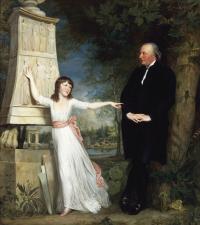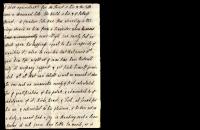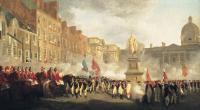The ‘oral-bishop’: the epicurean theology of Bishop Frederick Hervey, 1730–1803
Published in 18th–19th - Century History, Early Modern History (1500–1700), Features, Issue 3 (May/June 2012), Volume 20
Frederick Hervey, bishop of Derry, with his granddaughter, by Hugh Douglas Hamilton (1798)—not the painting stolen from St Columb’s Cathedral and placed on a bonfire in the Bogside. (National Gallery of Ireland)
Two summers ago in Derry, a portrait of the eighteenth-century earl-bishop Frederick Hervey was stolen from St Columb’s Cathedral and placed on a bonfire in the Bogside, to be consumed along with Rangers football paraphernalia and other artefacts of Protestant culture and identity. As the BBC news correspondent pointed out at the time, Hervey was far from the best choice of symbol to place on the sectarian bonfire, for the bishop was known for his lifelong commitment to Catholic relief—campaigning for political and civil liberties for Catholics 50 years before they were grudgingly granted. He also allowed Mass to be said in the crypt of his library, and invited the local priest to his dining table. He bankrolled the first Catholic chapel in Derry—Long Tower Church—and personally chose the magnificent Italian marble that adorns the altar. He undertook public works to relieve poverty, and was a generous patron to the Catholic population of Derry. In fact, if one wanted a poster-boy for ecumenism and parity of esteem, a figure for today’s Northern Ireland of peace and prosperity, of mutual tolerance, integrated schools and cross-community projects, not to mention sexual liberation, Bishop Hervey would do nicely.
Minor celebrity
A minor celebrity in his day, Hervey travelled widely on the Continent, where he kept company and correspondence with leading philosophers, princes, politicians, scientists, artists, architects and writers—including Voltaire, Goethe, Benjamin Franklin, John Strange, James Boswell and the pope. He was widely known as a brilliant conversationalist and wit who enjoyed a good argument almost as much as a fine wine. Best known to historians as a leader of the Ulster Volunteers, he famously led a triumphant procession from Downhill to Dublin in 1782. Decked out in an elaborate mix of military and ecclesial dress, in a carriage drawn by horses ornamented in matching purple and gold, and with dashing young parsons as outriders, the bishop entered Dublin with his customary modesty, hoping to change history and become king of a new tolerant Ireland. His political dreams were dashed at the Volunteers’ convention of 1782, where his ideas for Catholic enfranchisement and parliamentary reform were rejected. After this blow to his political ego, Hervey spent increasing amounts of time on the Continent, inserting himself into the centres of power, addicted to intrigue and spying, and becoming, according to his biographers, somewhat mentally unhinged. His love of fun and games got him into trouble in Rome, where he infuriated the Vatican by dressing up as a cardinal and where, from a second-storey window, he tipped a bowl of hot soup over a procession of the Blessed Sacrament. He once arrived at a monastery in France and presented himself as ‘a bishop from Ireland’, which the abbot took to mean one of their own kind—a mistake the bishop decided not to correct. He heard the confessions of every last monk that night.With the kind of CV outlined above, it is not difficult to see why Hervey has overwhelmingly been understood by historians as an eccentric egoist, a crank, a rogue, a ‘character’, a figure of fun as inflated and insubstantial as the raspberry puffs he loved to consume. Indeed, a search for Hervey on the electronic catalogue at the National Library of Ireland throws up, among other subject headings, ‘Eccentrics and Eccentricities of Great Britain’. Biographers have generally taken this same line, interpreting the young Hervey’s move from law to orders as thoroughly career-based and self-serving. He was, it seems, a bishop more interested in geology than theology, might well have chosen a good claret over Christ, and spent more time meditating on the layout of his kingdom at Downhill than on the kingdom of heaven. Historians generally agree that, despite his two doctorates in divinity, Hervey’s ecclesiastical career became a vehicle for a host of secular projects—politics, building, travel, patronage and women. Some have questioned whether he was a Christian at all. Others think that he is best described as ‘the deist of Derry’, an Enlightenment figure to his fingertips, whose interest in geology and science aligned him with critics of Christian teaching and the growing rejection of literal interpretations of the Bible.

A page from one of Hervey’s sermons, which offer a rare glimpse of his theological concerns. (Hervey/Bruce papers, MS D2798/1, PRONI)
Sermons
But the earl-bishop’s papers include a collection of some 25 sermons, dating from the beginnings of his church career through to his bishopric in Derry. The early sermons in particular offer a rare glimpse of Hervey’s theological concerns, and some foundational images for his later projects in Ulster. Specifically, his repeated metaphors for God—as patron, politician and builder—prefigure Hervey’s own whirlwind of reforms during his bishopric.Reading through Hervey’s sermons, one is struck by the persistent optimism of his version of Christianity—there are echoes here of Joseph Priestley’s Unitarian theology of benevolence, immanence and the absolute goodness of creation. In fact, his earliest sermons are meditations on creation and thanksgiving. Again and again he insists on the reckless, radical gift of creation, which gives us not simply the ‘necessary support’ to survive but an excessive ‘multiplicity’ of luxuries and delights. Hervey also asserts that creation becomes more valuable by our response of gratitude and pleasure. He compares this value-added condition to the relationship between food and the human palate: ‘a lively sense of warm return of the bounties of Providence bring to those bounties what our palate is to our food, to give us exquisite taste of what the common clap of men use only for their nourishment’. Because creation offers us ‘all that can delight as well as nourish’, Hervey asserts that the true Christian should enjoy the ‘marrow and fatness’ of this world while ‘their mouth praiseth God with joyful lips’. In other words, the same mouth that can appreciate the delicacy and wonder of a raspberry puff will necessarily open its lips also to praise God. (Interestingly, Hervey used the metaphor of drinking and taste to describe his decision to shift from law to orders: ‘Since I have tasted both the cups no one can wonder that I have preferr’d that w[hi]ch pleas’d my taste most’.)The ‘oral-bishop’ based his ethics on such capacity for oral pleasure, arguing that a world founded on Christian taste would give rise to ‘a general, pious, and friendly hospitality, not founded on gluttony or ostentation, but on social pleasure and true charity’. There is a connection made here between pleasure in food and pleasure in language, in eating and talking. Prayer, for the bishop, is an elegant ‘conversation’ or ‘intercourse’ with God. The palate capable of relishing the marrow and fat of our food suggests by extension a mind capable of delighting in company, and sharing in the ‘abundance’ or ‘affluence’ of creation. The same sermon meditates once more on the relational nature of creation, and the ways in which the human mind makes creation more meaningful and abundant by the act of reading, tasting and enjoying it. Hervey believes that this capacity for gratitude and delight in creation is the basis for all true charity—that one gives to his fellow creatures out of an attempt to share the wealth of creation and so add to the sum total of pleasure.

Right: The Dublin Volunteers on College Green, 4th November 1779, by Francis Wheatley. Hervey’s political dreams were dashed at the Volunteers’ convention of 1782, where his ideas for Catholic enfranchisement and parliamentary reform were rejected. (National Gallery of Ireland)
God as patron
One of Hervey’s persistent images for God is that of patron—an infinitely generous benefactor Whose giving has the effect of ‘enlarging’ the human capacity for love. This sense of largeness, of a bigger and wider context, is a repeated trope in Hervey’s sermons, and in his life and work—not surprising, perhaps, for a man who was reported to have been unable to breathe in small rooms (the outsized and cavernous spaces at Downhill suggest that size mattered very much to this edifying bishop). The bishop’s later generosity towards the lower orders in County Derry, his consistently favourable response to importunate letters from tenants, articulates some connection between his early theology and his later practices. A 1755 sermon describes God as one Who always ‘stoops to our weakness’, and Who shows ‘infinite mercy’ and ‘patience’, even towards a ‘rebellious people’. The bishop may have later thought of himself as a kind of god—critics understand him as puffed up, vain, extravagant, slightly mad and obsessed with his creation of Downhill. But we might also think of him as modelling himself on this excessively generous God, showing mercy towards a rebellious, recalcitrant people.Hervey’s commitment to Catholic emancipation and enfranchisement might be understood in the context of the theology outlined in the sermons. ‘The rights of humanity demand a general and unlimited toleration at all times’, he wrote in a letter of 1779. ‘Place us all on the same footing, and we shall all be equally good subjects’, he argued in one of his rants against the English treatment of Irish Catholics—the first person plural strangely allying him with his Catholic neighbours. The answer to the Irish question or the Irish problem of a disaffected Catholic majority is, for Hervey, not meanness but generosity. Just as God wins our prayers of thanksgiving by His extravagant generosity, so England could learn how to win over Irish Catholics by giving them more, not less. For Hervey, the Christian vision was one of enlarging the mind, and enlarging the human capacity for tolerance and love. His own life of boundless travel and generosity, along with his vast building projects, suggests an attempt to live out this vision. On this edge of Ulster, his extravagant life and building projects might be taken as a reaction against what he saw as the limits of a low church: his appetite for ever new delights, his taste for double portions of pleasure, might be understood as defying the sometimes tight-lipped Calvinism he found in his diocese.
Feel-good Christianity?
It would be easy to suggest that Hervey was offering up in these sermons a kind of easy-listening, feel-good Christianity for the upper classes—something that didn’t interfere with their fine living and gentlemanly pleasures, and nothing as distasteful as revelation, piety or uncritical belief. But these sermons suggest that revelation is another way in which God adds to our pleasure and enjoyment of this world. Nature can know something of pleasure, but revelation offers it in heightened form. In this sense, revelation is analogous to culture for Hervey: it gives us something more and better than what nature or biology can offer. Why settle for the grape of natural religion, in other words, when you can have the wine of revelation? Culture, like revelation, adds to and refines nature, takes it beyond the limits of biology, allows us an expansive, boundless, variable life. In this Hervey is able, in his large and encompassing way, to be at once orthodox and heterodox, to embrace both revealed and natural religion. By asserting the power of revelation, he aligns himself with the critics of deism; but with this analogy to culture, art and human creation, he aligns himself with cosmopolitan men of letters across Europe. He is able, like his infamously bisexual father, to have it both ways. In his sermon on the Creation, Hervey compares God to a master builder, ‘the divine workman’ Who creates by a ‘sort of consultation’ with the other members of the Godhead. Hervey imagines a ‘discussion’ between the members of the Trinity leading to the decision to ‘make man in our image’. Here again God is an Enlightenment gentleman, one Who consults with a team of like-minded builders, Who builds not just something good enough but very good indeed. Hervey’s vast building projects, his schemes and stratagems for reforming Ireland, his flitting around the Continent, are often taken as evidence of his eccentric behaviour, his hobbyhorse obsessions and his mental instability. But a close reading of his sermons may complicate that reading and suggest that while Hervey was busy making God in his own image, and making himself into a kind of god, he was also trying to imagine a more generous, tolerant and creative ruling power in Ireland. HI
Willa Murphy lectures at the School of English and History at the University of Ulster, Coleraine.
Further reading:
W. Childe-Pemberton, The earl bishop (2 vols, London, 1924).B. Fothergill, The mitred earl: an eighteenth-century eccentric (London, 1974).P. Rankin, Irish building ventures of the earl bishop of Derry (Belfast, 1972).J.R. Walsh, Frederick Augustus Hervey 1730–1803: le bienfaiteur des catholiques (Maynooth, 1972).
















